geology 2nd midterm reading quizzes
1/227
Earn XP
Description and Tags
chapter 5, chapter 8, interlude d, chapter 9, chapter 10, chapter 12, interlude e, chapter 11, interlude f, chapter 13
Name | Mastery | Learn | Test | Matching | Spaced |
|---|
No study sessions yet.
228 Terms
In 79 c.e., the citizens of Pompeii and Herculaneum in the Roman Empire were buried by pyroclastic debris derived from an eruption of __________.
Mt. Vesuvius
A passive eruption that primarily forms lava flows and minor scoria is termed a __________ eruption.
Hawaiian
Basaltic lavas that have rough, rubbly surfaces are called __________.
a’a’
What was unusual about the 1986 volcano-related disaster near Lake Nyos in Cameroon?
Volcanically derived carbon dioxide gas bubbled from the lake and suffocated people and animals nearby.
One of the most destructive lahars of recent times occurred after the eruption of Nevado del Ruíz in __________.
Colombia
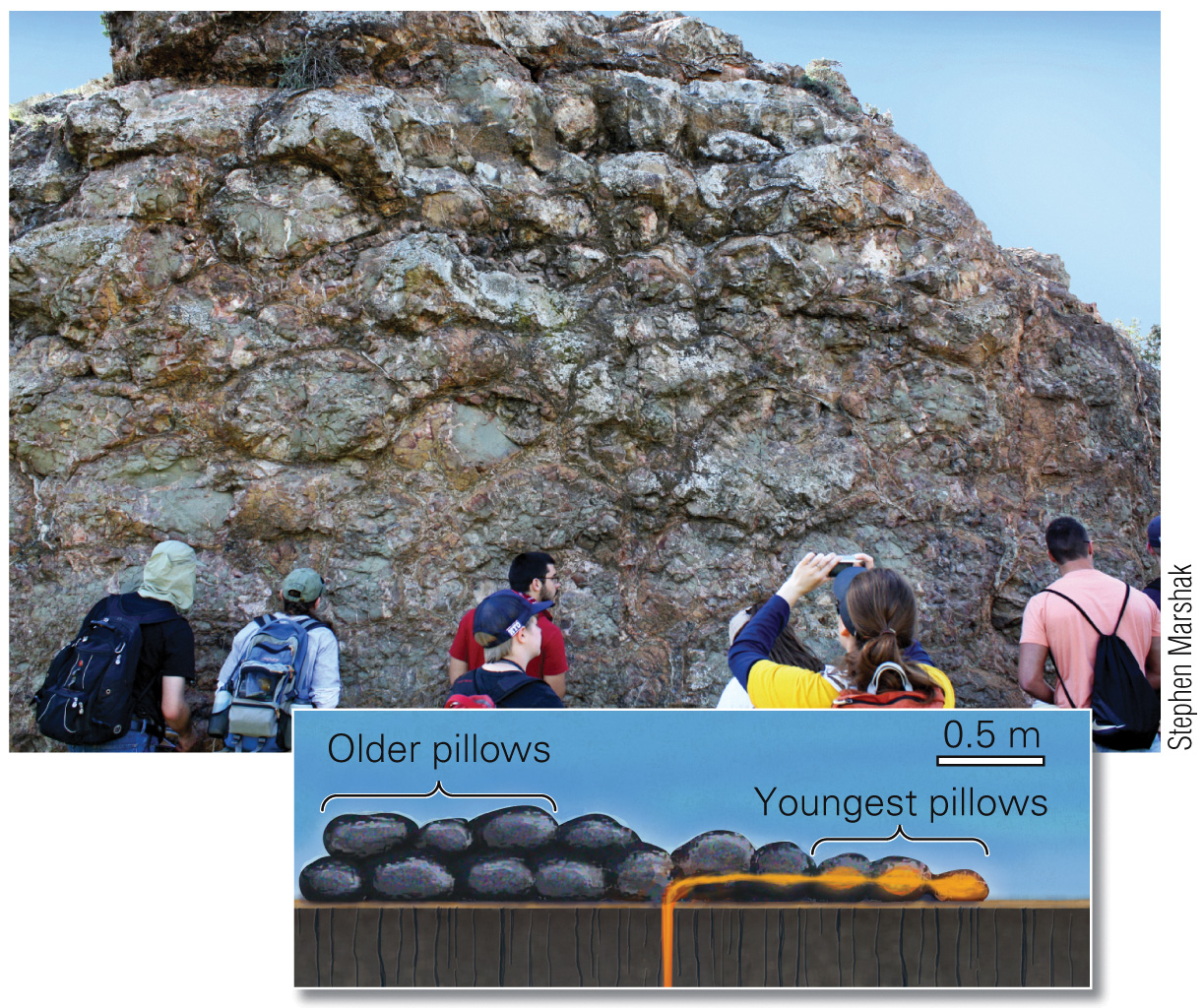
The pillow basalts in the photo below most likely formed __________.
underwater at a mid-ocean ridge
The Columbia River Plateau is an example of a __________.
flood basalt
A mixture of air, hot ash, and pumice lapilli that rushes down the side of a volcano in a scalding avalanche is termed a(n) __________.
pyroclastic flow
How do volcanic eruptions cool the Earth’s global average temperatures?
Ash and aerosols block incoming solar radiation.
Whether an eruption will produce lava flows or pyroclastic debris is influenced by the __________.
viscosity and the proportion of volatiles within magma
A fast-moving wet slurry consisting of a mixture of water and volcaniclastic debris is termed a __________.
lahar
The Hawaiian island chain is an example of a(n) __________.
hot-spot island chain
Techniques that volcanologists and geologists typically use to monitor volcanoes to determine whether an eruption is imminent include __________.
studying chambers and previous lava flows beneath dormant volcanoes
Ash, cinders, and blocks are all types of __________.
tephra
Of the three primary forms of subaerial volcanoes, __________ consist of a cone-shaped pile of tephra often formed in a single eruption.
cinder cones
Common volcanic gases include the following:
water vapor, carbon dioxide, and sulfur dioxide.
Pyroclastic flows pose a major hazard to life because they are __________.
hot and fast
Nonviolent eruptions characterized by extensive flows of basaltic lava are termed __________.
effusive
Olympus Mons, the largest known volcano in our Solar System, is an example of a __________.
shield volcano
Of the three primary forms of subaerial volcanoes, __________ are large cone-shaped mountains that consist of alternating layers of tephra and solidified lava.
stratovolcanoes
The characteristic “rotten egg” smell of many active volcanoes is derived from __________.
hydrogen sulfide gas
The textural term for a basaltic lava flow that has a smooth, ropy appearance is __________.
pahoehoe
When parts of an island-arc volcano slump into the sea, a large sea wave is produced and forms a hazard called a(n) __________.
tsunami
Volcanism in Iceland occurs as a result of __________.
eruptions from a hot spot that sits astride a mid-ocean ridge
If a volcano lies along a convergent boundary but has not erupted in over 1,000 years, the volcano is considered __________.
dormant
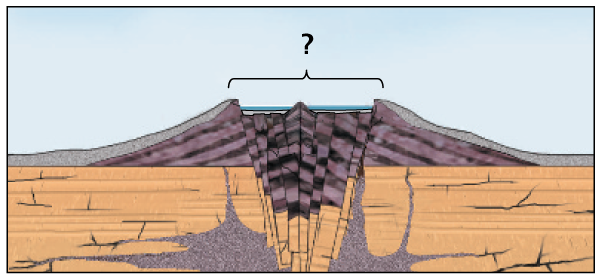
Explosive or voluminous eruptions may cause a volcano to subside or collapse into the now-empty magma chamber, producing a broad depression termed a __________.
caldera
Viscous lava that accumulates above a vent in a bulbous mass creates a __________.
lava dome
Geologists who specifically study earthquakes are called __________.
seismologists
At a minimum, how many seismic stations are necessary to locate the epicenter of an earthquake?
three
Most earthquakes are a result of __________.
lithospheric plate movement
Which earthquake scale measures the amplitude of deflection of a seismograph pen, standardized to an idealized distance of 100 km between the epicenter and the seismograph?
the Richter scale

Look at the figure below. Which letter corresponds to the S-wave arrival time?
B
Faults that have moved recently or are likely to move in the future are referred to as __________ faults.
active
The point on the Earth’s surface directly above the point where an earthquake occurs is termed the __________.
epicenter
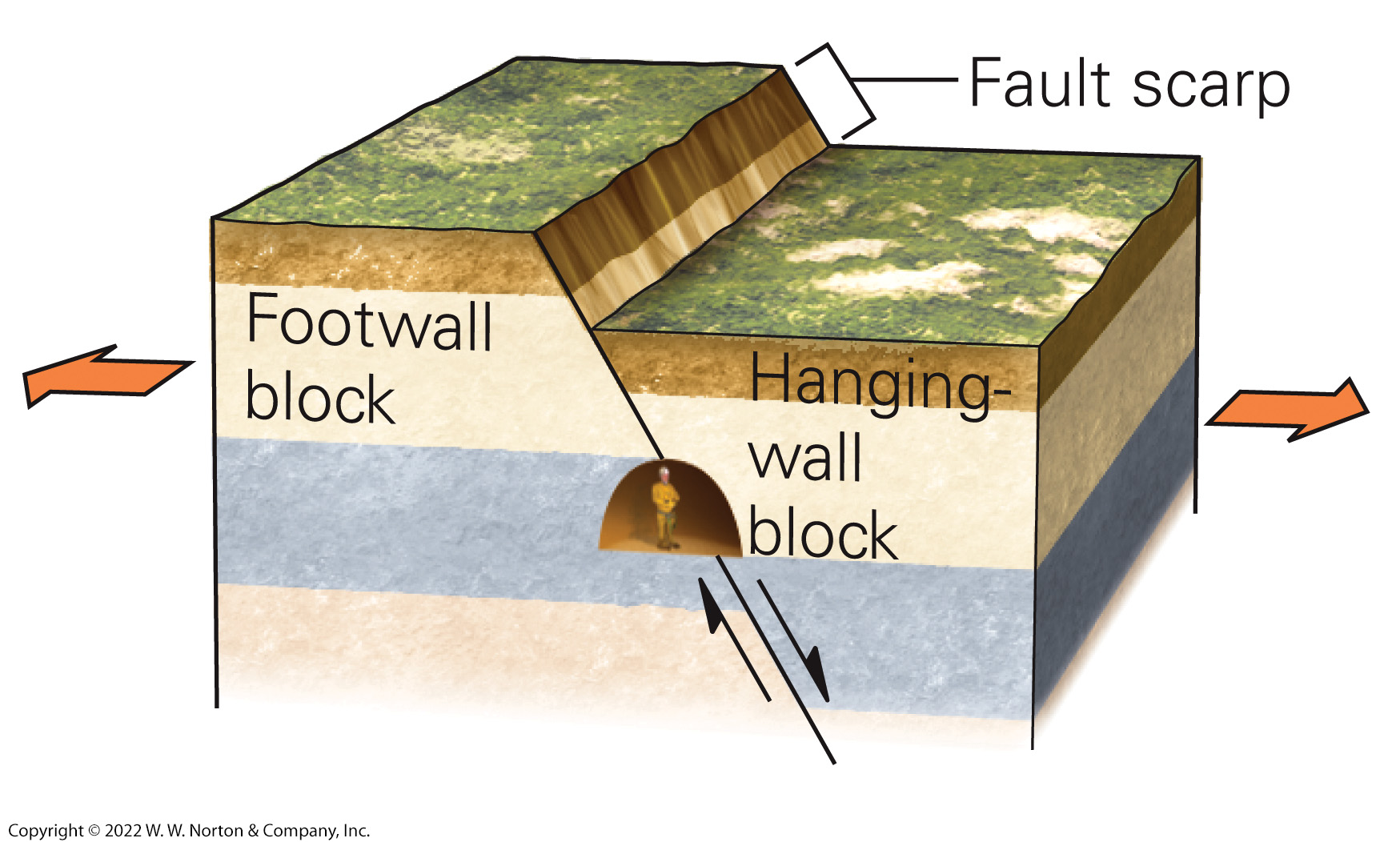
During an earthquake, if a footwall slides upward relative to a hanging wall (as shown in the figure below), the fault is termed a __________ fault.
normal
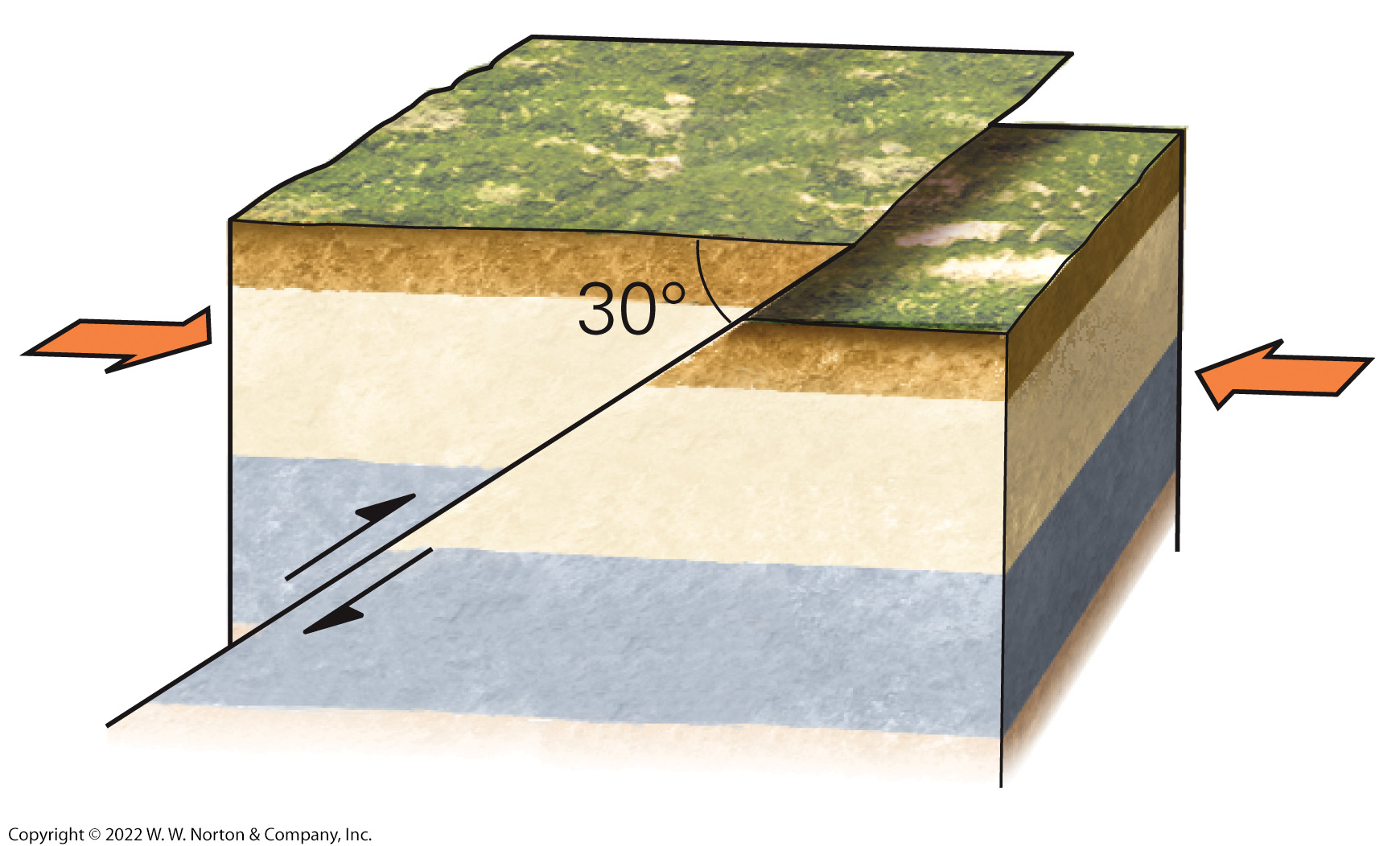
The figure below shows a particular type of fault that tends to develop in which type of plate tectonic setting (regime)?
compressional or shortening
Periods of intermittent sliding on a fault because of stress release during episodes of slip, followed by stress buildup to the point that the fault is reactivated, are termed __________.
stick-slip behavior
If a fault is nearly vertical in orientation and the two walls of rock on opposite sides slide past one another horizontally (as in the figure below), the fault is termed a __________ fault.
strike-slip
A primary force opposing motion on all faults is __________.
friction
Earthquake waves that travel along the Earth’s surface are termed __________.
surface waves
The point within the Earth where an earthquake originates is termed the __________.
hypocenter (focus)
Which earthquake scale is used to assess the effects of an earthquake on humans and human-made structures?
Mercalli scale
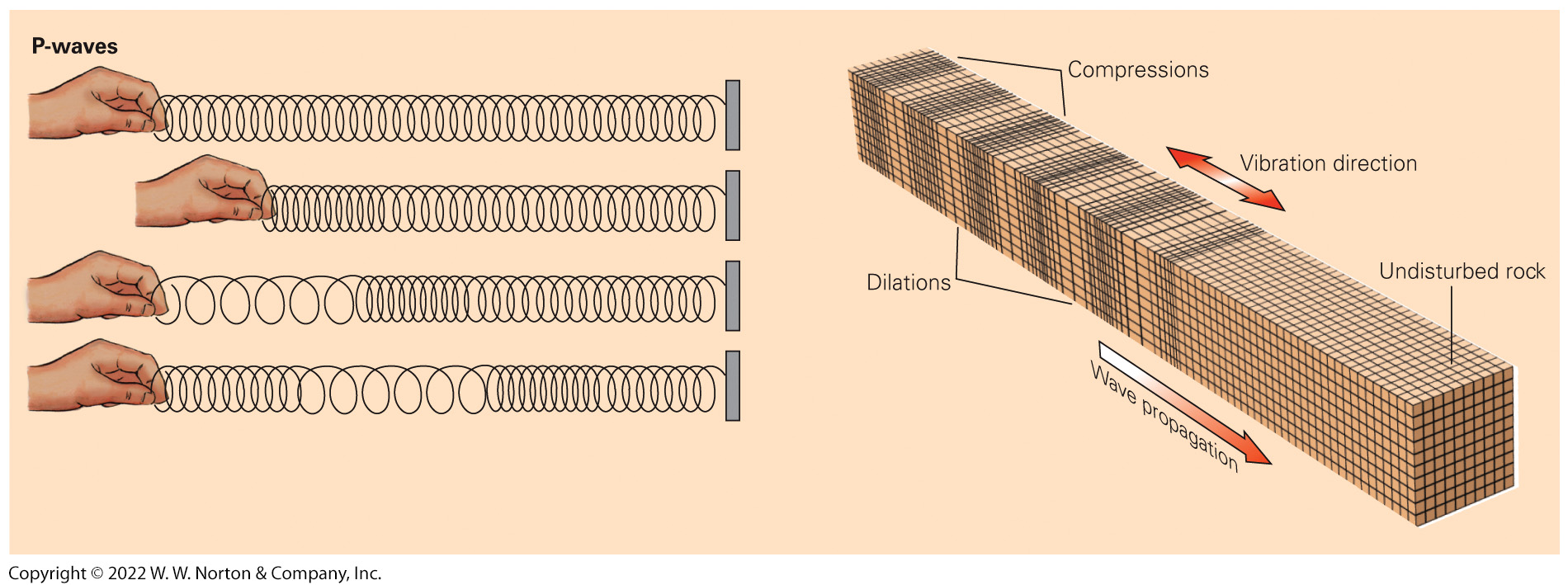
As shown in the figure below, a coiled spring would be useful in illustrating a __________ wave.
compressional
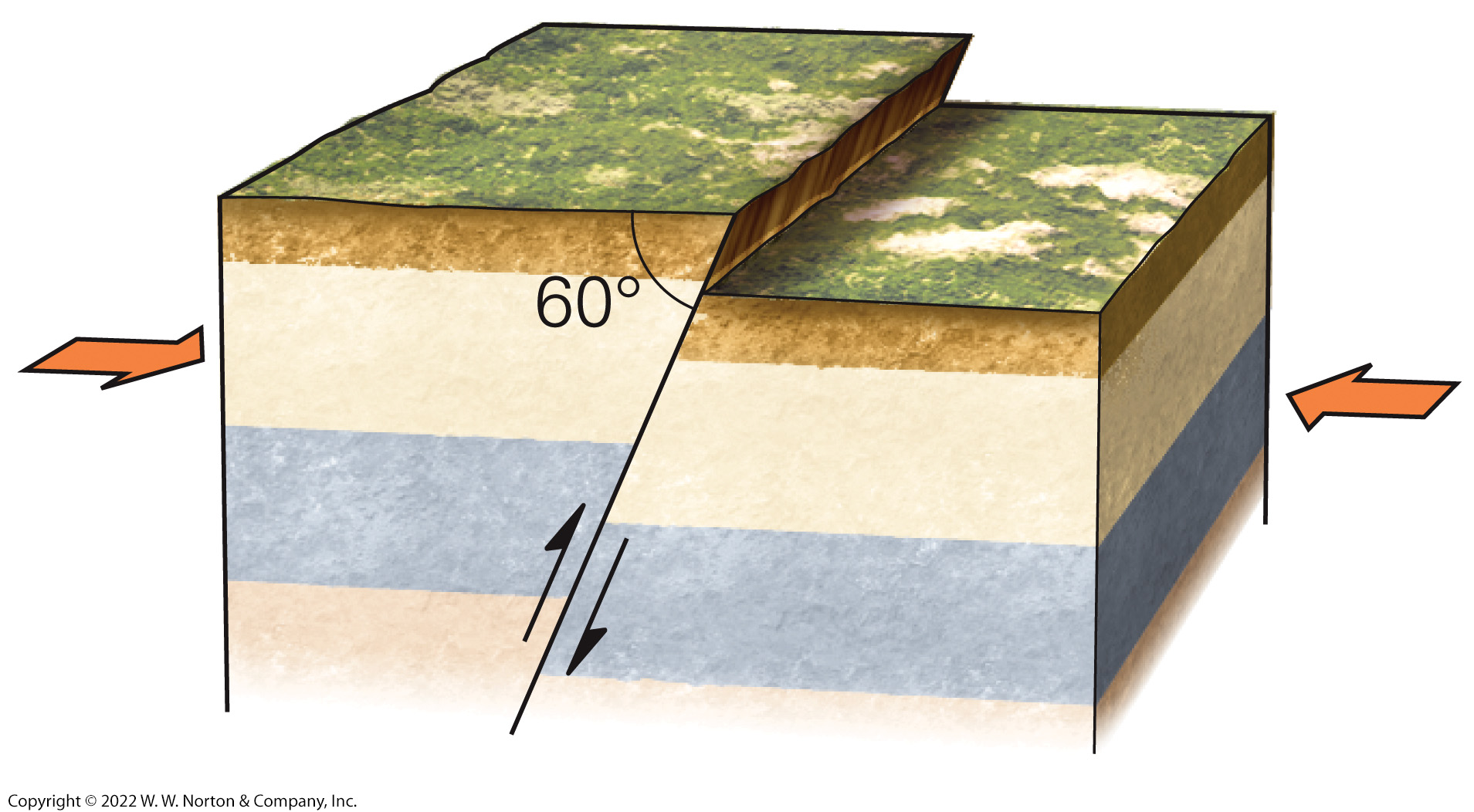
During an earthquake, if the hanging wall slides upward relative to the footwall, the fault is termed a __________ fault if the fault is steep (closer to vertical than horizontal). Refer to the figure below for an example of such a feature.
reverse
Generally, which type of earthquake waves travel with the lowest velocity?
surface waves
Imagine you are a geologist monitoring a set of seismic stations and the instruments detect an earthquake with a focus approximately 10 km deep in the middle of the ocean, well away from the coast. At which type(s) of plate boundary is the earthquake likely to have been generated?
divergent or transform
Long-term predictions of earthquakes
are based on past earthquake activity.
A tsunami is __________.
a sea wave generated by an earthquake, landslide, or submarine volcanic eruption that may destroy coastal cities thousands of kilometers from its source
Which type of seismic wave has the highest velocity?
P-wave
Short-term predictions of earthquake occurrence __________.
have been largely unreliable
An earthquake’s level of destruction does not simply depend on the earthquake’s magnitude. The magnitude 7 earthquake that struck the Port-au-Prince area of Haiti in 2010 was particularly deadly due to several other factors. One of those factors is that the city __________.
is built on steep hillsides underlain by weak sediment
Earthquakes that occur in a band called the __________ can be used to track the motion of subducted oceanic lithosphere.
Wadati-Benioff zone
Wet and unconsolidated substrates are uniquely susceptible to __________ during an earthquake.
liquefaction
If you are trapped inside during an earthquake, where should you avoid being?
next to a large bookcase
Most medium- and deep-focus earthquakes occur at __________.
convergent boundaries

Identify the layers of the Earth, from the outside to the interior, using the illustration below.
crust, mantle, core
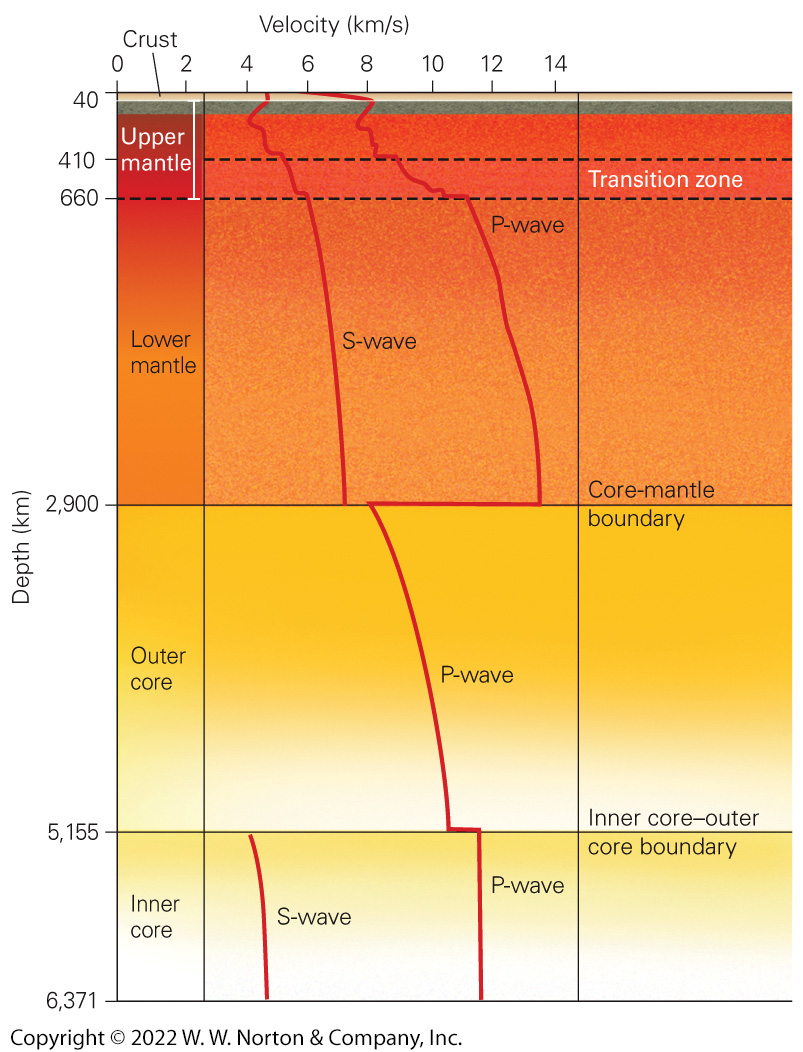
In the following graph, why does the line for S-waves NOT appear in the outer core?
S-waves cannot travel through the outer core because it is liquid.
The time it takes for a seismic wave to travel from the focus to a seismometer is called the __________.
travel time.
What causes the velocity of a P-wave to increase when it enters the inner core?
The inner core comprises much more dense material than the outer core.

In the picture below, when the ship is filled with cargo it sinks into the water until the mass of water displaced is equal to the mass of the cargo. The ship is then said to be __________.
in isostatic equilibrium
Seismic waves travel __________ in solids than in liquids; however, unlike P-waves, S-waves __________ travel through liquids.
faster; cannot
A positive magnetic anomaly is produced when the measured magnetic field strength is __________ the expected magnetic field strength.
greater than
The core consists of two layers: the __________ inner core and the __________ outer core.
solid; liquid
The Earth’s magnetic field is produced in the __________.
outer core
You are studying the seismic data from Mars when you notice that there are no S-waves recorded from 130° through 180° on the opposite side of the planet. What does this information tell you about the interior of Mars?
There is a layer of liquid material in the interior of Mars.
If a seismic wave is refracted upward at a boundary, what can be said about the material the wave is traveling through?
The wave is moving from a denser material into a less dense material.
Seismologists use seismic-velocity discontinuities to divide the mantle into the __________.
upper and lower mantle
If an S-wave is traveling through rock when it encounters a magma chamber, the S-wave will __________.
not travel through the magma
If a ship weighs 52,000 tons and is in isostatic equilibrium when 6,000 tons of cargo is added, what is the total mass of water that will be displaced by the ship after the cargo is added?
58,000 tons
Deformation results in the formation of ____________.
folds
The formation of the Basin and Range Province, a fault-blocked mountain range in Utah, Nevada, and Arizona, is associated with which of the following processes?
continental rifting
Why do earthquakes occur only above the brittle/plastic transition depth?
Below the transition, the rocks are too hot.
In a __________ fault, the fault plane is non-vertical and the hanging-wall block moves downward relative to the footwall block.
normal
An episode of mountain building is termed a(n)
orogeny.
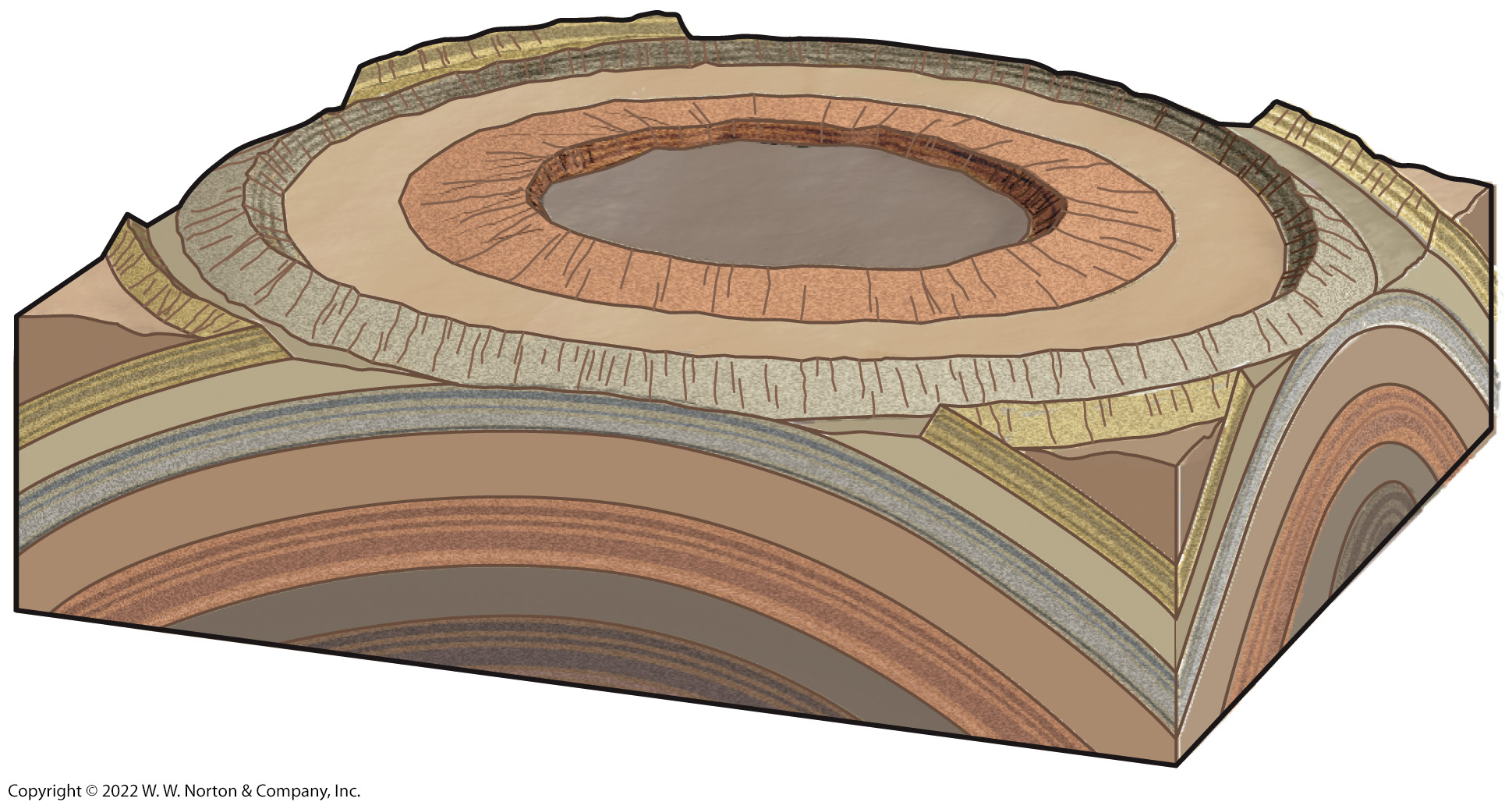
The rocks in the image below have been plastically deformed, resulting in a(n)
dome.
How does the rate at which a body of rock is deformed affect its behavior?
A rock deformed quickly is likely to exhibit brittle behavior.
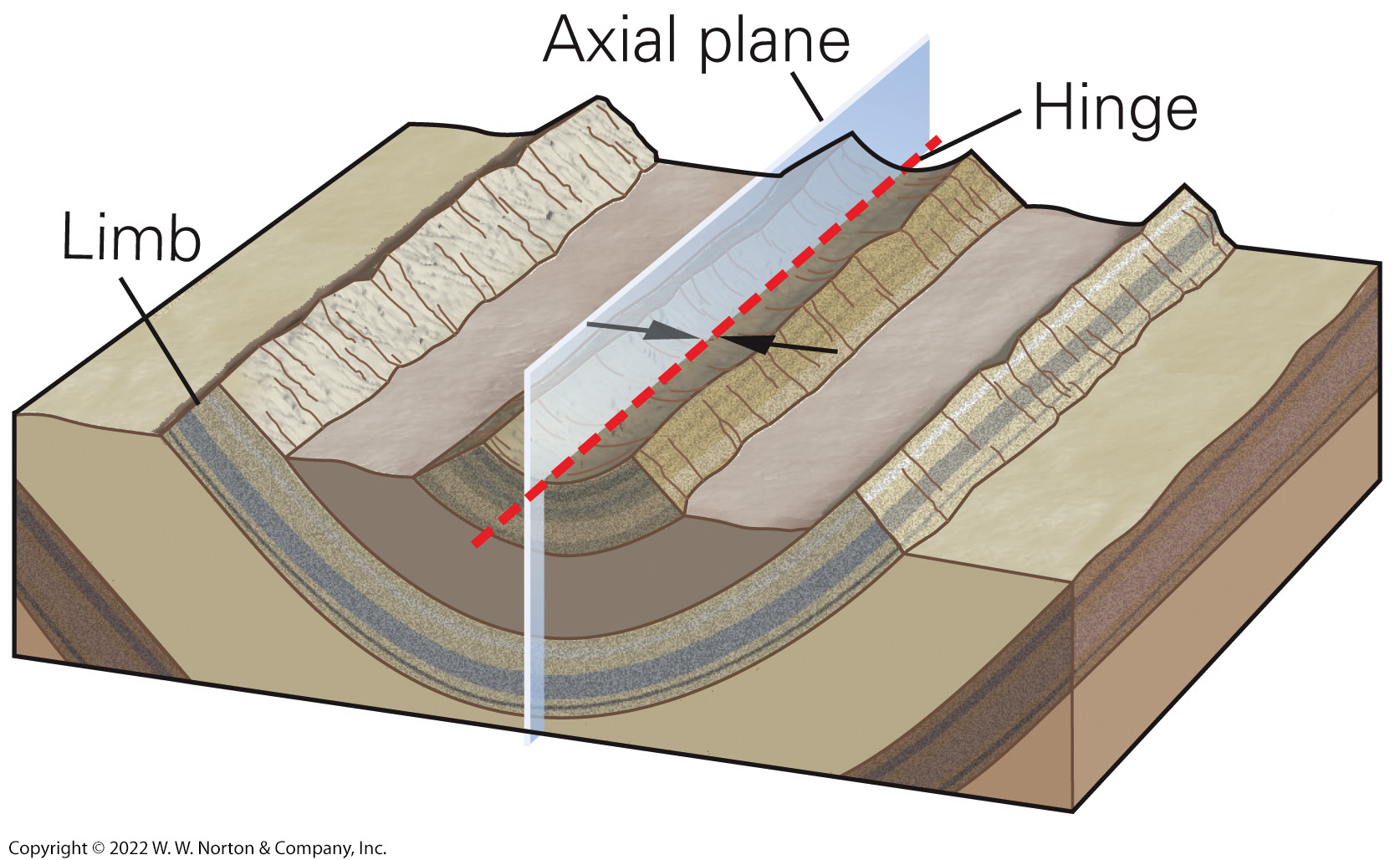
In the image below, the rocks have been bent into an elongate trough. This is a(n)
syncline.
Which of these properly illustrates the principle of isostasy?
Mountains stand high because they are gravitationally balanced by their deep crustal roots.
A polished surface produced by scraping of rock along a fault is termed a(n)
slickenside.
Force per unit area is termed
stress.
The distinction between joints and faults is that
faults are fractures along which displacement has occurred; displacement does not occur along joints.
A body of rock affected by compressive stress will likely undergo
shortening.
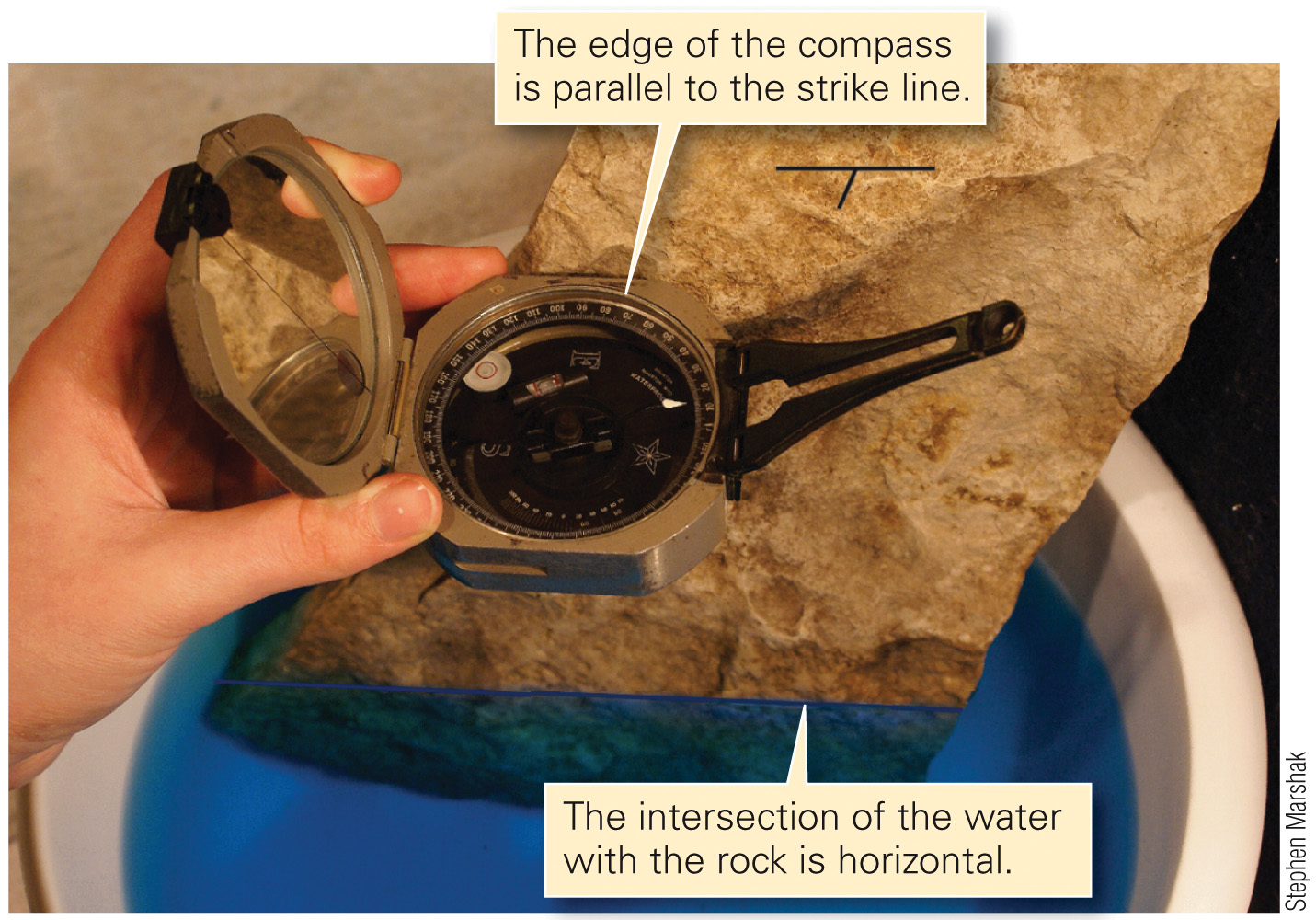
In the figure below, the horizontal line where the surface of the water intersects with the flat surface of the rock (which we can think of as a bedding plane) indicates the __________ of the “bed.”
strike
Regions of continents that have NOT been subjected to orogeny during the past 1 billion years are termed
cratons.
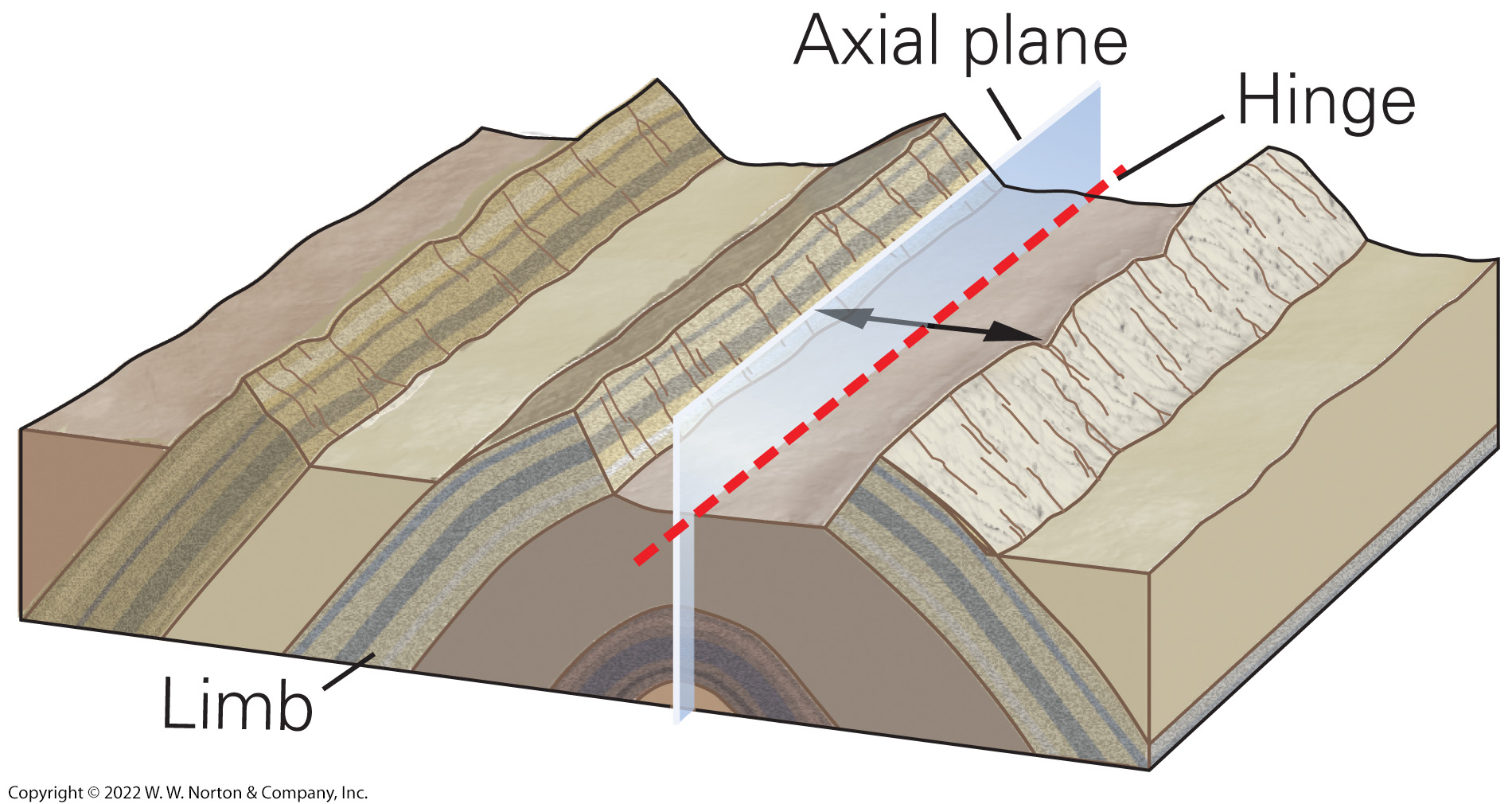
In the image below, the rocks have been bent into an elongate arch. This is a(n)
anticline.
Cratons are regions where Precambrian metamorphic rocks are exposed at the surface. They have not been affected by orogenies for at least 1 billion years, and therefore tend to be
cold and strong.
Right-lateral and left-lateral are both examples of __________ faults.
strike-slip
As subduction continues over a prolonged period, volcanic arcs, oceanic plateaus, and microcontinents may collide with the overriding plate (for example, the western part of the North American Cordillera). This process is called
accretion.
Rocks that simultaneously undergo metamorphism and deformation will likely develop
foliation.
Movement along faults often produces a rock formed from sharply angled rock fragments termed
fault breccia.
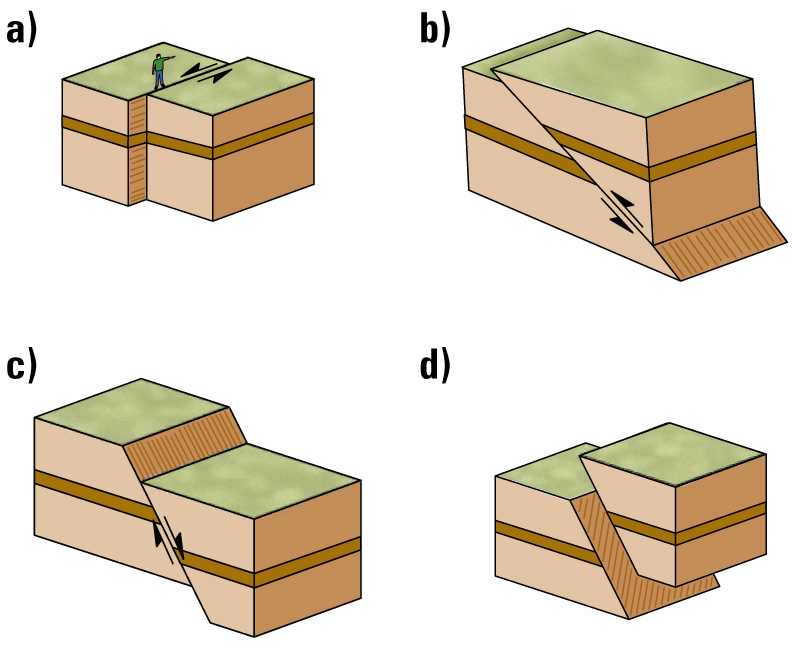
Which fault below could result from both strike-slip and dip-slip stresses?
D
What can be said about a mountain range that is being uplifted at 2 cm/year but is not growing any taller?
The rate of erosion is the same as the rate of uplift.
On a geologic map, if the contacts between sedimentary rock units form a bull’s-eye pattern of concentric circles, with the youngest unit in the center, the underlying structure is a(n)
basin.
Which method of correlation is most reliable for determining age equivalence among bodies of rock that are physically separated by vast distances?
fossil correlation
Buried erosional surfaces between parallel sedimentary strata are termed
disconformities
Two atoms of a single element that differ in number of neutrons are said to represent two distinct __________ of that element.
isotopes

Based on the figure, what is the age of Layer 7 relative to Layer 3?
Layer 7 is younger than Layer 3.
If a basalt body cuts across a fault, what are the relative ages of the basalt and the fault?
The fault must be older, according to the principle of cross-cutting relationships.
As understood by modern geologists, the principle of uniformitarianism implies that
physical processes observed today (such as erosion and volcanic eruptions) have been active in the past at roughly the same rates.
You can infer from their appearance that your geology professor is older than you even though you do not know their actual birthdate. This may be thought of as an example of
relative age dating.